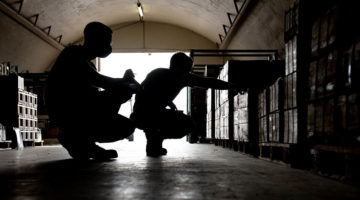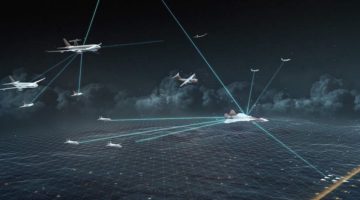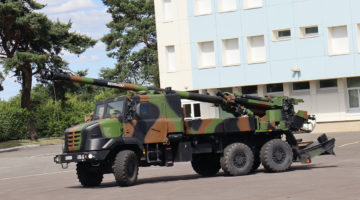Photo credit © USMC Pacific
The Ultra Heavy-Lift Amphibious Connector (UHAC) begins to rotate on the beach, July 9, at Marine Corps Training Area Bellows on Oahu, Hawaii during a Marine Corps Advanced Warfighting Experiment.
The AWE is the culmination of a decade of progressive experimentation conducted by the Marine Corps Warfighting Lab (MCWL) where they are testing potential future technologies, solutions and concepts to future Marine Air Ground Task Force challenges.
The AWE is taking part during the Rim of the Pacific (RIMPAC) Exercise 2014. Lt. Col. Don Gordon, the current technology officer at MCWL, said the UHAC is one of those experimental technologies that displays a possible capability of being able to insert Marines in areas where current technology wouldn’t be able to insert them based on current systems that are fielded.
The UHAC prototype is a ship-to-shore connector and is half the size of the intended machine. Currently, the UHAC travels at four knots using a track system with floatation-like pads that propels itself through different terrain.
According to an article by By Lance Cpl. Erik Estrada published on March 18, 2014:
Members of the Marine Corps Warfighting Lab arrived here to test a model version of the Ultra Heavy-lift Amphibious Connector (UHAC) March 3.
The UHAC is an amphibious craft that has three times the lift capacity and greater coastal access than the Landing Craft Air Cushion (LCAC.)
“It’s promising because it allows a greater lift and it’s exciting to see,” said Capt. James Pineiro, the Ground Combat Element branch head, at the Marine Corps Warfighting Laboratory.
Less than half the size of the actual UHAC, the Warfighting Laboratory was here to see their project in action for the first time after years of planning.
If the concept model goes through, the UHAC could work side by side with the LCAC, which currently does all the ship-to-shore transportation of everything from High Mobility Multipurpose Wheeled Vehicle (HMMWV) to tanks.
“The full-scale model should be able to carry at least three tanks and a HMMVW,” said Gunnery Sgt. Joseph Perera, the lab’s Infantry Weapons Project Officer. “It’s going to save a lot of time and fuel for the Marine Corps as well.”
Although the concept model doesn’t appear to be armored well, the final production is planned to have armor plating and .50-caliber machine guns, which Perera says are needed on the UHAC to be able to protect itself.
“The UHAC’s goal is to have more combat power and breach the land further than the LCAC,” said Pineiro.
“All this is part of the ‘next effort’ that the Office of Naval Research and the Marine Corps Warfighting Lab are looking at for connectors, which bring more combat vehicles and power to shore quickly,” said Mr. Geoffrey Main, Program Manager at the Office of Naval Research. “The UHAC full scale should climb a 12 to 16 foot wall when it is completed. It can go over everything short of a 16 to 18 foot seawall.”
According to Main, this would mark a big improvement, since the LCAC can only go over a three to four foot wall.
Main was around at the beginning when Navatek, Ltd., a ship-building company from Honolulu, came to the Office of Naval Research and proposed the UHAC project in 2008. MCWL liked the idea and began to proceed with the project.
“Initially it was for another program,” said Main. “We saw it was compatible with the well deck and that it would provide three times the capability of the LCAC, but yet, in the same space as the LCAC.”
In the upcoming exercise Rim of the Pacific 2014, the half-scale UHAC is slated for an Advanced Warfighting Experiment (AWE) where it will disembark from a ship and make its way onto shore. This will give the Navy and Marine Corps forces a closer look at the UHAC and its abilities.
Although the UHAC is still an experiment, members of the MCWL believe if it passes its experimentation process and makes it to the fleet, it would help the Marines and Sailors tremendously.
“Not only does it provide more combat power much more quickly, but access to beaches and littoral environments” said Main. “[It allows] a lot more options ashore, which is extremely valuable … because our adversaries are developing ever better capabilities to repel a landing. The best defense against that is having many (options).”
And according to Jeremy Bender in a piece on Business Insider published on July 10, 2014:
The Marine Corps Warfighting Lab, in conjunction with the Office of Naval Research, is currently testing a beast of an amphibious lander.
The Ultra Heavy-Lift Amphibious Connector (UHAC) has been developed as a replacement to the current Landing Craft Air Cushioned (LCAC). The UHAC would be used to bring ashore troops, equipment, and vehicles. It can even land multiple tanks at once.
The UHAC began testing on July 9 at the Marine Corps Training Area Bellows on Oahu, Hawaii and it is taking part in the Rim of the Pacific Exercise 2014 which is currently underway until August 1. We have highlighted some of the amazing capabilities of the UHAC below.
The current iteration of the UHAC is only half the size of the expected final version, although it is still massive: 42 feet long, 26 feet wide, and 17 feet high.
At full capacity, the UHAC should be able to carry three main battle tanks ashore from a range of 200 nautical miles.
Altogether, the UHAC can carry payloads up to 190 tons, almost three times as much as the LCAC.
Unlike the LCAC, the UHAC can continue moving while onshore across mud flats, tidal marsh areas, and even over sea walls of up to 10 feet in height. This movement is due to the UHAC’s treads, which are composed of low pressure captive air cells held within foam casings.
But the vehicle is limited to speeds up 20 knots, half that of the LCAC, due to drag from its foam treads.
For a video of the UHAC being tested see the following link.












